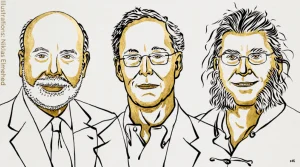15 Oct 2022 Nobel in Economic Sciences
Source: The Hindu; The Indian Express

Image Credit: The Hindu
News: Ben Bernanke, Douglas Diamond and Philip Dybvig awarded the Nobel Prize 2022 for Economics ‘for research on banks and financial crises’.Royal Swedish Academy of Sciences in its statement said that this year’s Nobel laureates “have significantly improved our understanding of the role of banks in the economy, particularly during financial crises. An important finding in their research is why avoiding bank collapses is vital.”
Key Contributions of Ben Bernanke, Douglas Diamond and Philip Dybvig:
- According to Ben Bernanke failing banks accounts for the lion’s share of the economic downturn.
- Douglas Diamond and Philip Dybvig explain the reasons for bank’s existence, their role in society and the collapse of banks due to rumors.
- Solution to bank vulnerability presented by Diamond and Dybvig is deposit insurance from the government. Depositors will no longer rush to bank in case of rumours about bank run as they knew that the state has guaranteed their money.
- Nobel laureate Douglas Diamond shows that banks perform societally important functions.1)Banks are intermediaries between savers and borrowers.2) Banks can properly assess borrowers’ creditworthiness 3)Banks are in a good position to ensure that loans are used for good investments.
Ben Bernanke gave the reason for Great Depression:
- Before Bernanke, Bank Failures is seen as one of the “consequences” of the financial crisis. But Bernanke in his 1983 paper proved that bank failures were the “cause” of the financial crisis.
- His analysis of historical sources and statistical methods showed that failing banks account for the lion’s share in the drop of GDP.
- He analyzed the Great Depression of the 1930s and came to the conclusion that bank runs turned the normal recession of 1929 into a full full-fledged banking crisis by 1930 leading to the greatest economic crisis in modern history.
- His wisdom that letting banks fail often worsens a financial crisis are backed by empirical studies.
Tools provided by Bernanke in preventing bank runs:
- Recovery of the economy depends on powerful measures implemented by the state to prevent additional bank panics.
- Provisions of deposit insurance: where some portions of one’s deposits in a bank are insured.
Analysis of Douglas Diamond and Philip Dybvig:
- Banks have lost their sheen in the public eye after the Global Financial Crisis of 2008. People started seeing banks as money-grabbing institutions that exist to borrow profit from depositors as well as borrowers. But, it would be impossible to make any long-term investment without banks.
- Papers published by Diamond and Dybvig in 1983 showed that there are “fundamental conflicts between the needs of savers and investors”.
- Liquidity needs of Savers as they always wanted access to some part of their savings for unexpected use. From Banks, they expect the ability to pull out money according to their need.
- Borrowers or Investors who took out loans for building homes or roads need money for a much longer time. So, these Borrowers will face issues when money can be demanded back at a short notice.
- Solution provided by Diamond and Dybvig to solve this mismatch: Construction of exactly bank-like institutions. Theoretical model developed by Diamond and Dybvig explains how banks create liquidity for savers, while borrowers can access long-term financing.
- Banks through the process of maturity transformation can resolve this conflict.
- Bernanke, Dybvig and Diamond’s work had laid the foundation for modern bank regulations and through this management of financial crises.
Nobel Prize in 2021 for Economics went to David Card, Joshua Angrist and Guido Imbens
- David Card’s research shows how the minimum wage, immigration and education affect the labor market.
- Joshua Angrist and Guido Imbens proposed methodology to study issues that don’t easily fit traditional scientific methods.
Key terms:
|
Articles:
1.Banks’ role in financial crises(Udit Misra)
2.Economics Nobel announced: The winners’ work in how banks function
3.Economic Sciences Nobel for trio’s research on banks and financial crises
Article Links:
1.https://indianexpress.com/article/explained/explained-economics/nobel-prize-economics-2022-banks-role-in-financial-crises-8201293/
2.https://indianexpress.com/article/explained/explained-economics/understanding-why-research-on-modern-banking-won-economics-nobel-8200648/
3.https://www.thehindu.com/news/international/three-economists-win-nobel-for-research-on-banks-and-financial-crises/article65992110.ece


No Comments